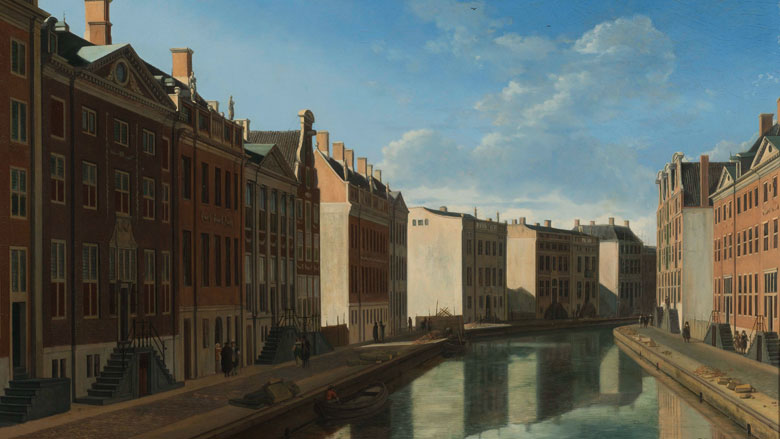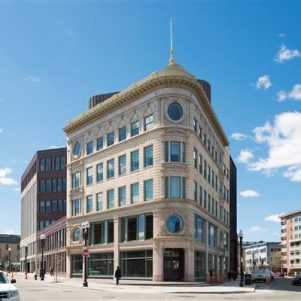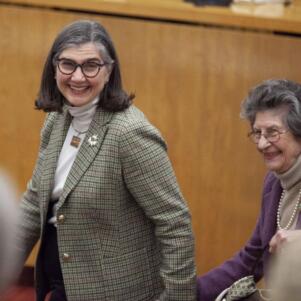PEM’s ‘Asia in Amsterdam’ exhibit combines culture and commerce
By Diane Kilgore | February 25, 2016, 14:00 EST
 The Bend in the Herengracht, Amsterdam by Gerrit Adriaensz. Berckheyde. (Wikimedia)
The Bend in the Herengracht, Amsterdam by Gerrit Adriaensz. Berckheyde. (Wikimedia) “Asia in Amsterdam: The Culture of Luxury in the Golden Age” is the latest exhibition of marvel at the Peabody Essex Museum. Now through June 5, visitors of the PEM are welcome to explore a sensational presentation of art and cultural innovation through commerce, using all five senses. The museum, in the center of Salem, Mass., is the exclusive U.S. venue for this series, which was five years in the making and co-organized by the Rijksmuseum of Amsterdam.
Columns of cinnamon, clove and peppercorns artfully infuse the gallery air as the exhibition begins to tell tales of adventure, domesticity, fashion, gastronomy, intrigue, and, sadly, the massacre of thousands of Banda Islanders in the name of nutmeg. The spicy essence of inspiration offers an aromatic hint of what guests will inhale as they follow the flow of galleries exploring the museum’s interpretations of exotic ports of call across China, India, Japan, Sri Lanka and Vietnam before sailing back to Amsterdam’s hub.
Asia in Amsterdam explains the history of The Dutch East India Company or VOC (Verenigde Oostindische Compagnie). The organization was the world’s most powerful shipping company of the 1600s. It was, as Karina Corrigan, the curator of the exhibit explains, the birthplace of “today’s global equities market.” Employing more than 40,000 Dutch, European and Asian workers, its 100 ships maintained 600 posts in Asia. The VOC was first established to import highly prized spices from the Maluku Islands of Indonesia but soon expanded its trading to include refined textiles, jewels, lacquers, and porcelains. Those treasures fascinated the Dutch, who voraciously surrounded themselves with the exotic trappings of prosperity earned through their experience with globalization.
PEM has created a sense of the “Culture of Luxury in the Golden Age” with an immersive experience showcasing 200 works of art that help explain international trading in the 17th century and how it transformed Dutch culture and the world. Many of the assembled artifacts are from the PEM’s own world-renowned Asian export holdings, other objets d’art have been culled from 60 other worldwide collections, some borrowed from The National Gallery of Art in Washington, and The Hague, and private collections from around the world. A few of the most impressive treasures in the exhibition are on loan from British, Swedish and Dutch royal households.
Galleries show how, through trading, the cumbersome monochromatic clothing of the period was supplanted by imported cottons and silks with wild colors and patterns. Men, women and children began wearing vivid, flowing tunics and colorful skull caps in place of roughly hewn fabrics. Elegant gentlewomen of the era in Holland wore enormous, exotic diamond and pearl jewelry to convey not only prosperity but a direct connection to Asia. The exhibit also includes a wide display of fine porcelains and emblematic delftware as well as other household furnishings, such as armoires, chests, and cradles covered in ivory, mother of pearl and lacquers. A surprising “guess what this is” display will leave visitors chuckling with its accommodating nod to the impracticality of practicality.
Adding melodic contemplative dimension to the tour is “The Golden Dream: 17th Century Music from the Low Countries,” by the Newberry Consort with Marion Verbruggen and Paul O’Dette, which escorts guests as they wander in wonder through the “Thought Leaders” section of the exhibition. Amsterdam was the epicenter of trade in that period, which allowed Dutch scholars the opportunity to consider the worlds of far off places, their peoples, plants, animals, religions and medical practices. Some of those combined curiosities are displayed in multiple media formats that link one of the 17th century’s most historically relevant and dynamic cities to present day experiences.
Saturday, Feb. 27, is the opening day of this fanciful exhibit. Included in the general admission: visitors of the PEM are welcome to celebrate its arrival with art making activities and film as well as chat with the curators, designers and artists who expand upon the notions of how 17th century Amsterdam influences our lives today.
On Saturday, April 16, the public is invited to a gather at the museum for a “Study Day,” where a deeper exploration and examination of Amsterdam’s consumption of Asian influences will be explained through paintings, textiles, and cuisines. Members $80, non-members $90, students with IDs $40. The day, which runs from 9:30 a.m. to 6 p.m., includes lunch, cocktails and museum admission. Lunch will be inspired by 17th century cooking. Reservations required by April 8.
On Thursday, April 21, the museum hosts an after-hours party of traditional and electronic music and will serve Asian and Dutch beers to guests to further celebrate the harmony of cultures at the PEM. Free for members, $10 for non-members.
PEABODY ESSEX MUSEUM
161 Essex Street Salem, Massachusetts
978-745-9500
PEM.ORG/CALENDAR











